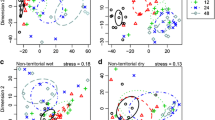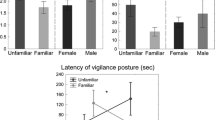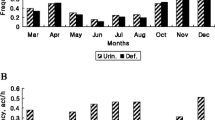Abstract
Many mammals enhance their olfactory signals visually by depositing them in conspicuous locations such as well-travelled paths. It is also possible to enhance the odour itself through behaviours aimed at modifying odour emission rates. White rhinos defecate in communal middens. While defecating, territorial males kick sharply with their back feet which disperses their dung. Despite being a ubiquitous trait of territorial male white rhinos, the reason behind this behaviour is unclear. We hypothesised that the purpose of dung kicking was for olfactory signal amplification (OSA) in terms of an increased emission of volatile compounds (i.e. increased signal strength). Using dung collected from non-territorial adult males (because it is not possible to collect whole dung from territorial males), we show that the dispersal of male white rhino dung causes OSA by increasing the emission of hydrocarbon acids. The dung odour of territorial and non-territorial males differs only quantitatively, hence it is likely that the same emission patterns occur for territorial male dung odours following dung dispersal. The volatile compound indicating age of intact dung was toluene, but for dispersed dung it was acetophenone (similar to territorial male dung). Despite the benefits of OSA, dung dispersal carried a cost of decreased odour longevity. Thus, signal detectability is temporally reduced. However, territorial males likely counteract this by defecating in middens both before and during peak visitation times by other individuals (15:00–23:00). As a result, we suggest that dung kicking by territorial males amplifies signal strength, such that their dung odours are the most prominent and easily detectable by individuals visiting the middens. This would then better signal territorial ownership to both potential rivals and potential mates.







Similar content being viewed by others
Change history
11 March 2019
The original version of this article unfortunately contained some mistakes.
11 March 2019
The original version of this article unfortunately contained some mistakes.
References
Alberts AC (1992) Constraints on the design of chemical communication systems in terrestrial vertebrates. Am Nat 139:S62–S89
Amirav A, Dagan S (1997) A direct sample introduction device for mass spectrometry studies and gas chromatorgraphy mass spectrometry anlyses. Eur J Mass Spectrom 3:105–111
Andersen KF, Vulpius T (1999) Urinary volatile constituents of the lion, Panthera leo. Chem Senses 24:179–189
Archie EA, Theis KR (2011) Animal behaviour meets microbial ecology. Anim Behav 82:425–436
Archunan G, Rajagopal T (2013) Detection of estrus in Indian blackbuck: Behavioural, hormonal and urinary volatiles evaluation. Gen Comp Endocrinol 181:156–166
Asa CS (1993) Relative contributions of urine and anal-sac secretions in scent marks of large felids. Am Zool 33:167–172
Barja I, de Miguel FJ, Barcena F (2004) The importance of crossroads in faecal marking behaviour of the wolves (Canis lupus). Die Naturwissenschaften 91:489–492
Barja I, de Miguel FJ, Bárcena F (2005) Faecal marking behaviour of Iberian wolf in different zones of their territory. Folia Zool 54:21–29
Bartoń K (2013) MuMIn: multi-model inference. R package version 1.9.13. The Comprehensive R Archive Network (CRAN), Vienna
Bossert WH (1968) Temporal patterning in olfactory communication. J Theor Biol 18:157–170
Brachares JS, Arcese P (1999) Scent marking in a territorial African antelope: II. The economics of marking with faeces. Anim Behav 57:11–17
Burger BV, Viviers MZ, Bekker JPI, Le Roux M, Fish N, Fourie WB, Weibchen G (2008) Chemical characterization of territorial marking fluid of male Bengal tiger, Panthera tigris. J Chem Ecol 34:659–671
Burnham KP, Anderson DR (1998) Model selection and inference: a practical information-theoretic approach. Springer-Verlag, New York
Cross HB, Zedrosser A, Nevin O, Rosell F (2014) Sex discrimination via anal gland secretion in a territorial monogamous mammal. Ethol 120:1044–1052
Elkinton JS, Cardé RT (1984) Odor dispersion. In: Bell WJ, Cardé RT (eds) Chemical ecology of insects. Springer US, Boston, pp 73–91. https://doi.org/10.1007/978-1-4899-3368-3_3
Estes RD (1991) The behavior guide to African mammals. Univ California Press, Berkeley
Giotto N, Laurent A, Mohamed N, Prevot N, Gerard J-F (2008) Observations on the behaviour and ecology of a threatened and poorly known dwarf antelope: the Beira (Dorcatragus megalotis). Eur J Wildl Res 54:539–547
Gorman ML, Mills MGL (1984) Scent marking strategies in hyaenas (Mammalia). J Zool 202:535–547
Gosling LM, Roberts SC (2001) Scent-marking by male mammals: cheat-proof signals to competitors and mates. Adv Study Behav 30:169–217
Hayward MW, Hayward GJ (2010) Potential amplification of territorial advertisement markings by black-backed jackals (Canis mesomelas). Behaviour 147:979–992
Hillman-Smith AKK, Owen-Smith N, Anderson JL, Hall-Martin AJ, Selaladi JP (1986) Age estimation of the white rhinoceros (Ceratotherium simum). J Zool 210:355–379
Jordan NR, Manser MB, Mwanguhya F, Kyabulima S, Rüedi P, Cant MA (2011) Scent marking in wild banded mongooses: 1. Sex-specific scents and overmarking. Anim Behav 81:31–42
Karthikeyan K, Muniasamy S, SankarGanesh D, Achiraman S, Archunan G (2013) Faecal chemical cues in water buffalo that facilitate estrus detection. Anim Reprod Sci 138:163–167
Lerdau M, Guenther A, Monson R (1997) Plant production and emission of volatile organic compounds. BioScience 47:373–383
Liaw A, Wiener M (2012) Classification and regression by randomForest. R News 2:18–22
Marneweck C, Jürgens A, Shrader AM (2017a) Dung odours signal sex, age, territorial and oestrous state in white rhinos. Proc R Soc B Biol Sci 284:20162376
Marneweck C, Jürgens A, Shrader AM (2017b) Temporal variation of white rhino dung odours. J Chem Ecol 43:955–965
Marneweck C, Jürgens A, Shrader AM (2018) The role of middens in white rhino olfactory communication. Anim Behav 140:7–18
Monfort A, Monfort N (1974) Notes sur l’écologie et le comportement des oribis (Ourebia ourebi, Zimmerman, 1783). Rev Ecol 28:169–208
Müller-Schwarze D, Houlihan PW (1991) Pheromonal activity of single castoreum constituents in beaver, Castor canadensis. J Chem Ecol 17:715–734. https://doi.org/10.1007/BF00994195
Nimmermark S, Gustafsson G (2005) Influence of temperature, humidity and ventilation rate on the release of odor and ammonia in a floor housing system for laying hens. Agric Eng Int 7:1–14
Oksanen J et al. (2015) Vegan: community ecology package. R package version 22-1
Osbourn AE, Lanzotti V (2009) Plant-derived natural products: synthesis, function, and application. Springer, New York
Owen-Smith N (1971) Territoriality in the white rhinoceros (Ceratotherium simum) Burchell. Nature 231:294–296
Owen-Smith N (1973) The behavioural ecology of the white rhinoceros. The University of Wisconsin
Owen-Smith N (1975) The social ethology of the white rhinoceros Ceratotherium simum (Burchell 1817). Z Tierpsychologie 38:337–384
Piñeiro A, Barja I (2012) The plant physical features selected by wildcats as signal posts: an economic approach to fecal marking. Die Naturwissenschaften 99:801–809
Pinheiro J, Bates D, DebRoy S, Sarkar D, Team RC (2015) nlme: linear and nonlinear mixed effects model. R package version 3.1–117
Rachlow JL, Berkeley EV (1998) Correlates of male mating strategies in white rhinos (Ceratotherium simum). J Mammal 79:1317–1324. https://doi.org/10.2307/1383023
Sharpe LL (2015) Handstand scent marking: height matters to dwarf mongooses. Anim Behav 105:173–179
Skinner JD, Chimimba CT (2005) The mammals of the southern African sub-region. Cambridge University Press, Cambridge
Somers M, Rasa OAE, Apps PJ (1990) Marking behaviour and dominance in suni antelpe (Neotragus moschatus). Z Säugetierk 55:340–352
Stoddart DM (1976) Mammalian odours and pheromones. Edward Arnold Ltd, London
Team RC (2016) A language and environment for statistical computing. R Foundation for Statistical Computing, Vienna
Theis KR, Schmidt TM, Holekamp KE (2012) Evidence for a bacterial mechanism for group-specific social odors among hyenas. Sci Rep 2:615
Tinley KL (1969) Dikdik Madoqua kirki in South West Africa: notes on distribution, ecology and behaviour. Madoqua 1:7–33
Vogt K, Zimmermann F, Kolliker M, Breitenmoser U (2014) Scent-marking behaviour and social dynamics in a wild population of Eurasian lynx Lynx lynx. Behav Process 106:98–106
Walther FR (1990) Duikers and dwarf antelopes. In: Parker SP (ed) Grzimek’s encyclopedia of mammals, vol 5. McGraw-Hill, New York, pp 325–343
White AM, Swaisgood RR, Zhang H (2002) The highs and lows of chemical communication in giant pandas (Ailuropoda melanoleuca): effect of scent deposition height on signal discrimination. Behav Ecol Sociobiol 51:519–529
Zielinski WJ, Vandenbergh JG (1993) Testosterone and competitive ability in male house mice, Mus musculus: laboratory and field studies. Anim Behav 45:873–891
Acknowledgements
We thank Dr. Adam Shuttleworth for processing GC-MS samples and Chris Kelly (WildlifeACT Fund) for use of camera traps.
Author information
Authors and Affiliations
Corresponding author
Rights and permissions
About this article
Cite this article
Marneweck, C., Jürgens, A. & Shrader, A.M. Ritualised Dung Kicking by White Rhino Males Amplifies Olfactory Signals but Reduces Odour Duration. J Chem Ecol 44, 875–885 (2018). https://doi.org/10.1007/s10886-018-0988-3
Received:
Revised:
Accepted:
Published:
Issue Date:
DOI: https://doi.org/10.1007/s10886-018-0988-3




